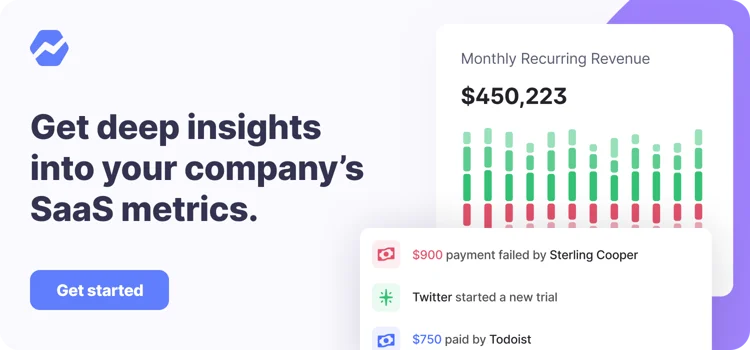Table of Contents

We’ve staked the success of our business, RightMessage, on a big assumption:
More relevant, more targeted messaging and call-to-actions make people think “OK, this thing is obviously meant for me” – the tangible side effect being more leads, more conversions, and more sales.
So it would be a bit silly for a product that helps companies personalize to not be personalizing our own website. After all, we should be the poster child for personalization done right.
This isn’t a pitch for our product
If you’re reading this article, you most likely run a software business. You have developers on staff.
You’re a peer of mine, and I want to talk to you as a fellow business owner.
While you could use our software to eliminate a need to reroute engineering resources to implement some of the ideas I’ve listed below, any engineer worth their salt should be able to act on the strategies below. And once implemented, most of the strategies will deliver an ROI fairly immediately (as in days, not months.)
Let me rephrase that: The strategies below are micro-projects that your engineers should be able to pull off. And once they’re implemented, they’ll yield immediate and ongoing results.
If I do my job right, in a few minutes I’ll have convinced you that:
- Getting the basics of personalization up and running won’t take too much time, but will have a lasting impact on your overall conversions.
- You’re already using many of these strategies, especially when attempting to sell anyone over a demo, a sales meeting, or at a conference afterparty.
What is the “job” of your marketing site?
Founders are attached to our products.
We think that everyone wants to read every line of copy we throw onto our website and geeks out on wading through the myriad of features, integrations, and use cases that we’ve detailed.
In truth though (and – come on, this isn’t any surprise), no one cares as much as you do.
People are impatient.
The job of your marketing site is two-fold:
- Clearly and quickly communicate how you’re able to help.
- Get somebody to act based on how problem and product-aware they are. (Opt-in to a lead magnet, request a demo, purchase, or upgrade)
That’s it.
But here’s the problem:
- People don’t all have the same problem. Some are aware of the problem your product solves, some aren’t.
- People want to be certain that your product can help *them*. So they want to see how you’ve helped others just like them.
- Not everybody who engages with you is ready to actually be a customer.
This makes communicating how you can help tricky, because different people have different needs.
And since your website says the same thing to everyone, what call-to-actions should you use? Should somebody who just showed up from Google and has read one blog post of yours be treated the same as someone who’s been on your list for months?
When selling offline, these issues are easily addressed.
If I’m selling project management software and I’m at a conference for agency owners, I can assume whoever I’m speaking to owns an agency. And I probably have an idea of why agencies buy our software. Easy enough. And if I’m talking with them, I should be able to figure out fairly quickly whether they’ve ever heard of our software and how they’re managing projects now.
Armed with this data, I’ll naturally tweak how I describe my product. I’ll talk about other agencies using the software and the results they’ve had. The features I focus on will be agency-ish. And so on. But when you’re selling at scale on your marketing site, you’re effectively delivering a monologue – and the same script is being read off to everyone.
When you’re talking to everyone, you’re reaching no one.
This is where personalization comes in.
What if you can take the data you already have about someone and make changes to your website?
- If they’re in the construction industry, make the headline on the homepage about construction, change the case studies to be other construction companies, and talk about construction stuff on your features and pricing page.
- If they’re already on your list and have familiarity with your product, stop trying to get them on your list with annoying popups and, instead, get them to sign up for a trial.
- If they’re already a customer, get them to consider upgrading to your annual plan the next time you email them a blog post.
…And the list goes on.
Below you’ll find five strategies that will make your website a little more relevant and personalized to the people, both new and old, who are engaging with your company.
Strategy #1: Where are people coming from?
Who sends people to your website?
If you’re not sure, take a minute to load up Google Analytics and find out what pages are consistently sending you traffic.
For each of the major referrer, ask yourself:
- What type of people read the referring website?
- What does it say about someone who was reading the page or article that sent them to you?
- Can you get a testimonial from the person who owns the website?
Pat Flynn of SmartPassiveIncome.com sends a lot of traffic to ConvertKit.
The savvy people at ConvertKit know that Pat’s audience is fiercely loyal. What kind of impact do you think a personalized landing page has, featuring a testimonial from Pat talking about how awesome ConvertKit is?
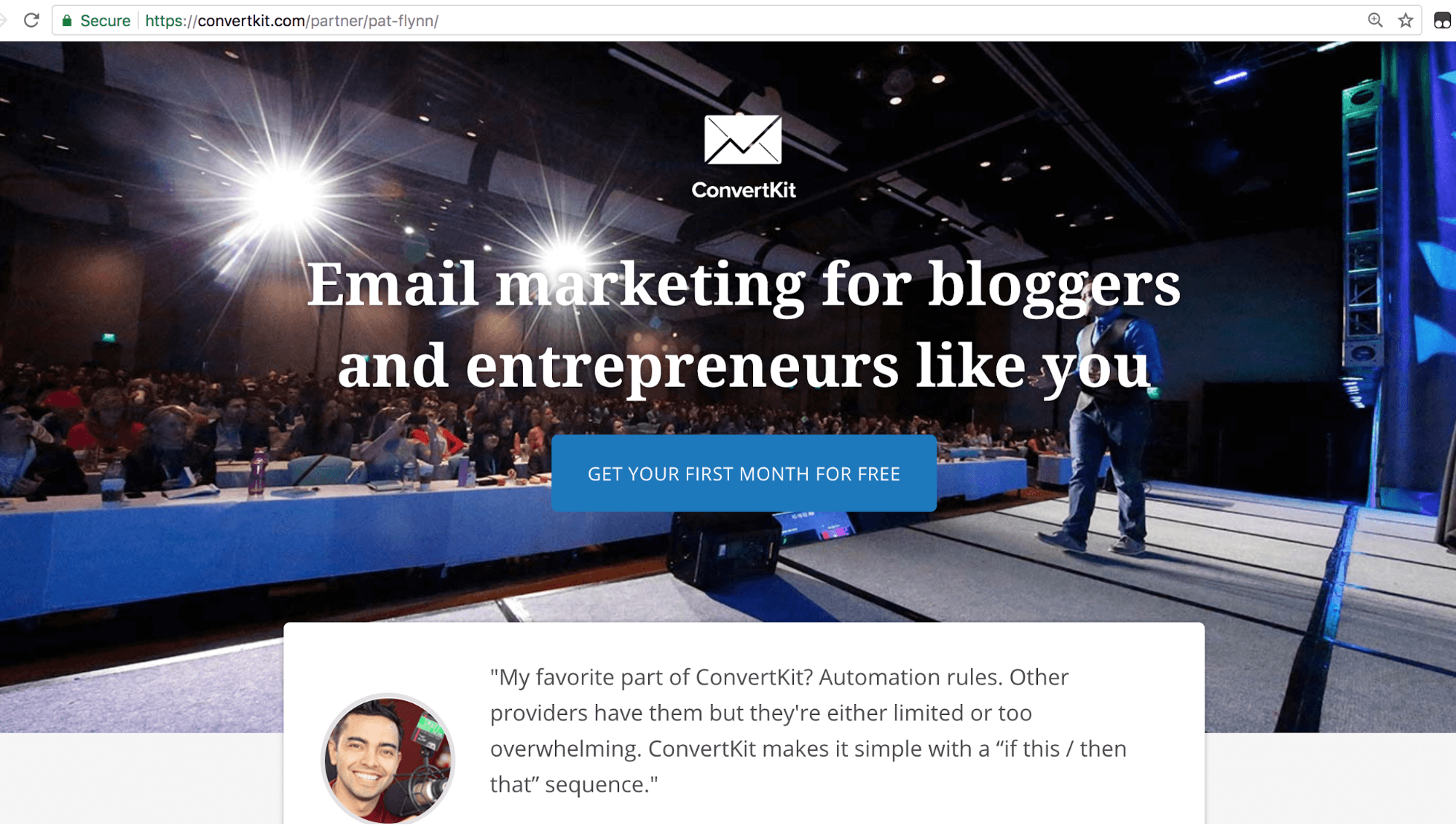
What if they just saw this?
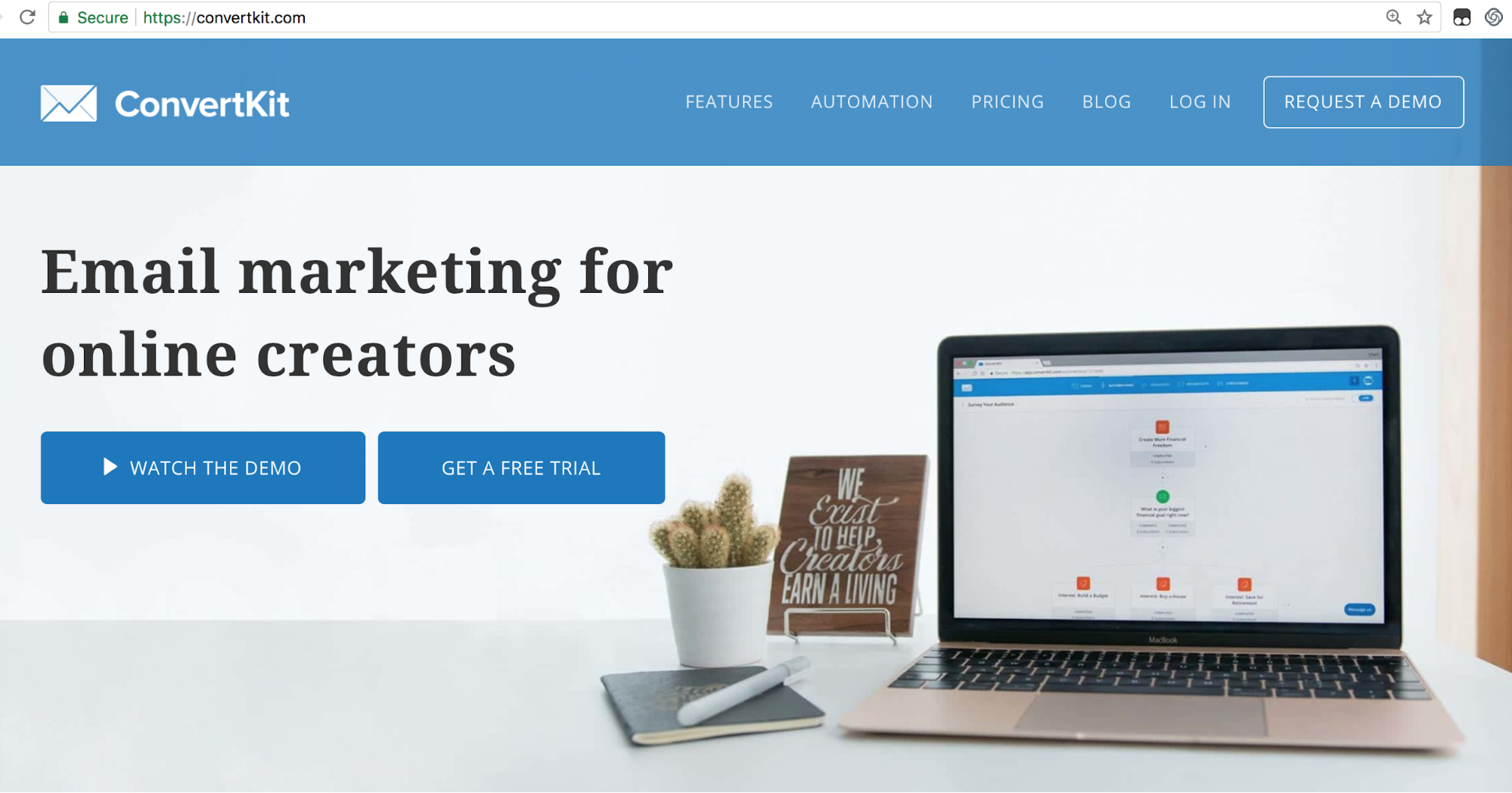
By taking into account the type of person who reads SmartPassiveIncome.com and the social currency Pat Flynn carries with his readers, ConvertKit is able to make their software the email marketing product for people who like Pat.
One of our customers, Bookafy, has a campaign setup where they’re changing parts of his homepage hero based on traffic that comes from review websites.
Here’s what he’s doing for Capterra traffic:
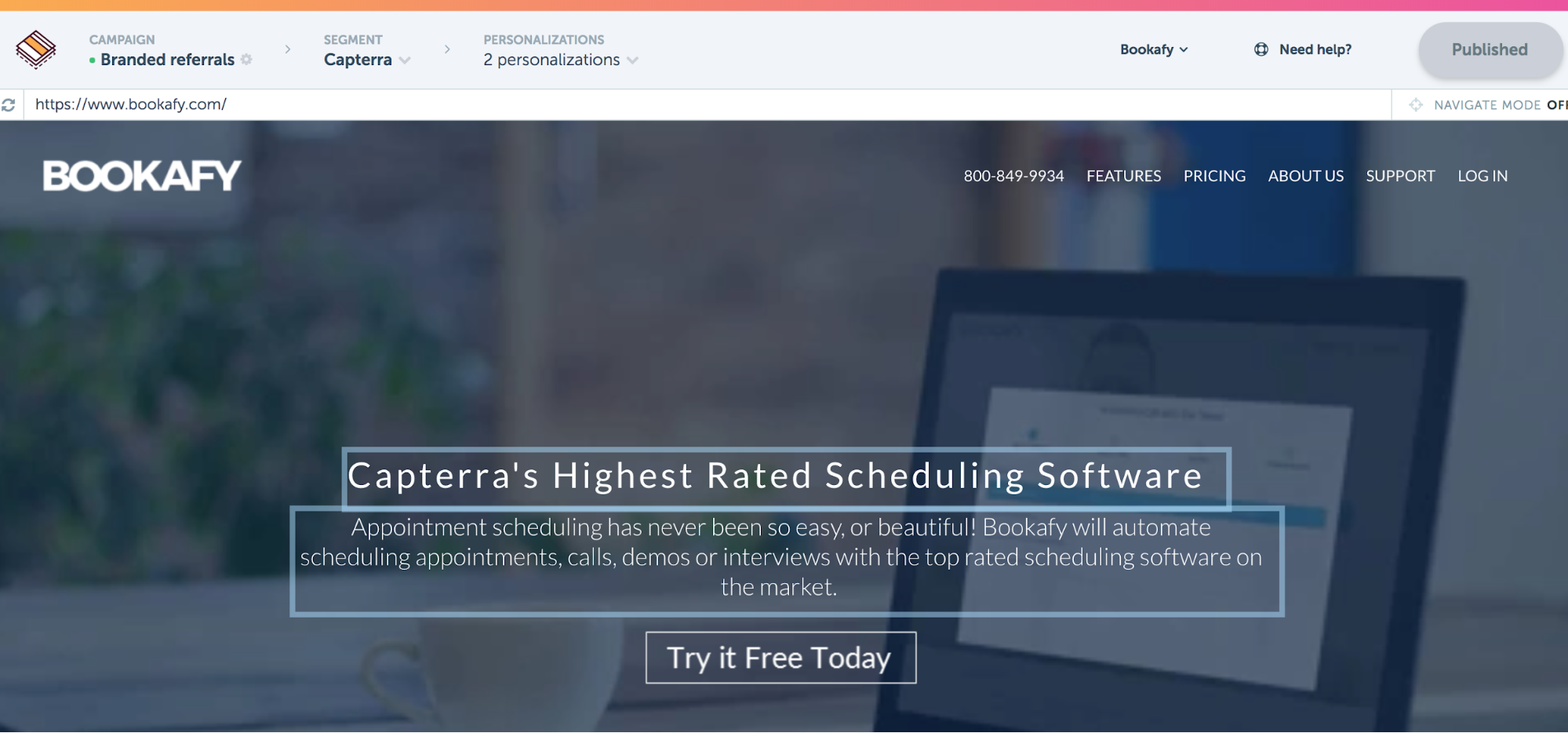
The result?
Traffic from Capterra typically converts at 4.2%. After changing the hero section to reinforce the website they arrived from, they’re now converting at 7.8% – an 84% improvement.
Another one of our customers, Tom Morkes, recently ran an online summit. He partnered up with about a dozen affiliates, and made it so that the headline, bits of supporting copy, and testimonials would change depending on the affiliate.
The results? For one affiliate, registrations went from 53.6% to 70.6% (32% lift.) Another went from 31.3% to 62.6% (101% lift.)
It worked because he figured out what kind of audience each affiliate attracted, redid the headline to talk about how his summit would help them, and included the name and photo of the affiliate prominently on the registration page.
Simple changes that yield big results.
Action Step
When a new user visits your website, write the referrer to a cookie or redirect to a dedicated landing page. Have conditions that change parts of your website based on the presence and value of that cookie.
Strategy #2: Use their lingo
Sadly, Google pulled the plug on exposing to site owners the keywords their visitors were searching for. While this data is still available in the Search Console, we can no longer tie it to an individual.
However… the page they land on can often give us clues about what they might have been looking for.
Consider the following article on my website, Double Your Freelancing.
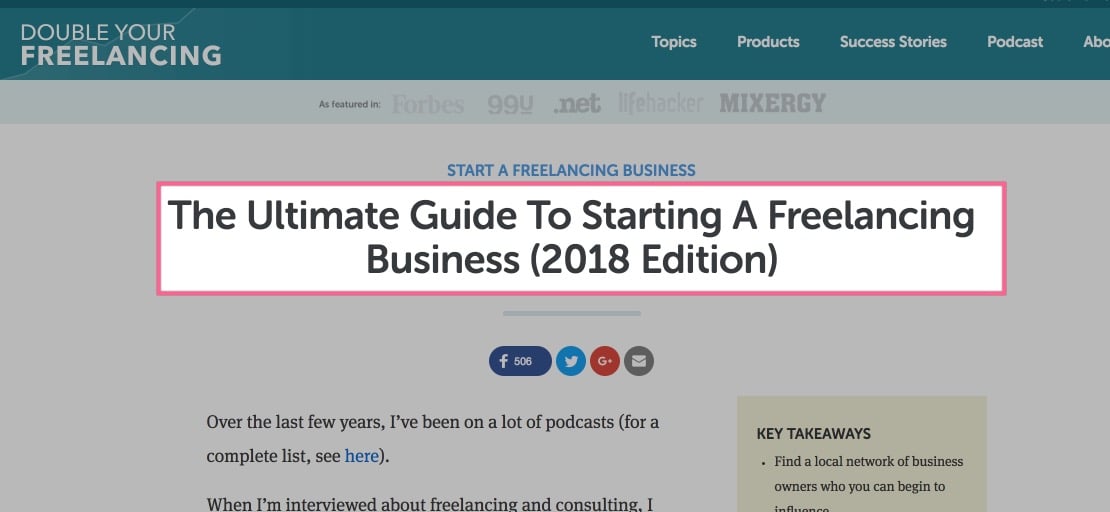
It gets a fair amount of organic traffic. Let’s look at the keywords that drive people to this article:
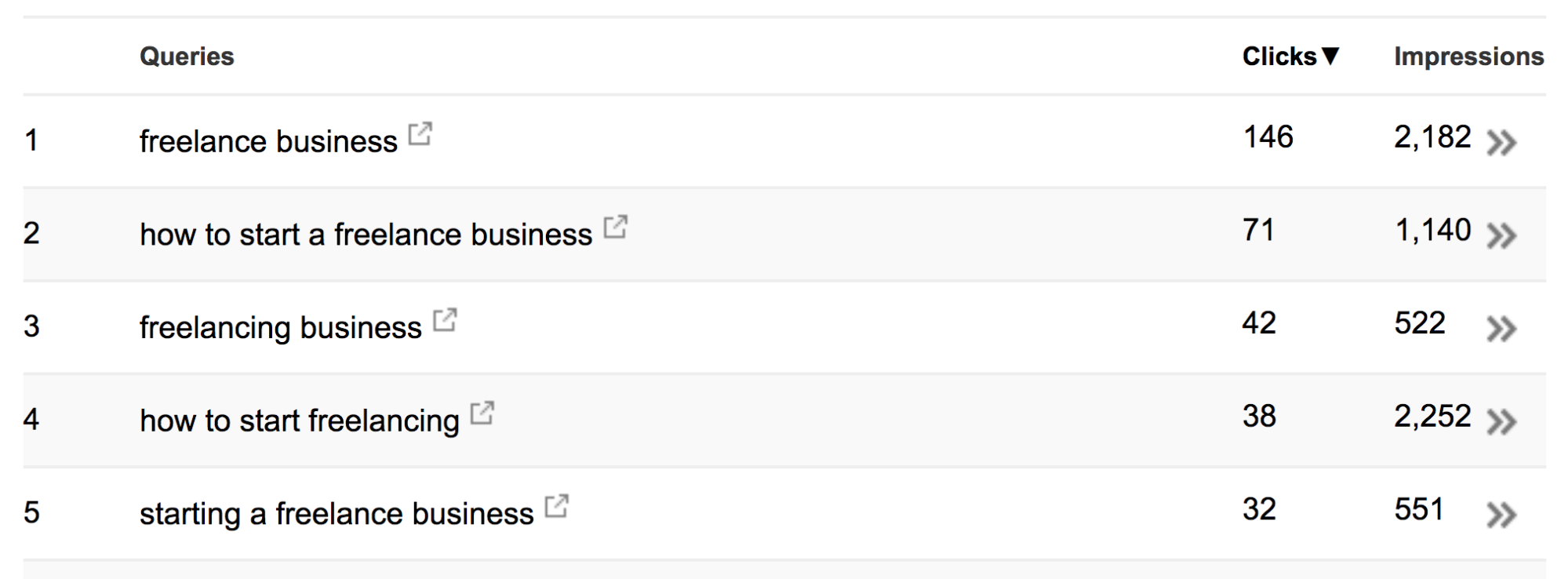
These aren’t people who want to scale an agency or start pricing themselves as a premium consultant. They want to get started freelancing.
If their first interaction with me is this guide, it’s safe to assume that they’re just starting out – or thinking about starting out.
I do this throughout my website. I look at the type of content they’re reading and the type of site they came from (if applicable), and change how I phrase my sitewide call-to-action.
Here’s what someone referred from a design blog and binging articles on writing proposals would see:

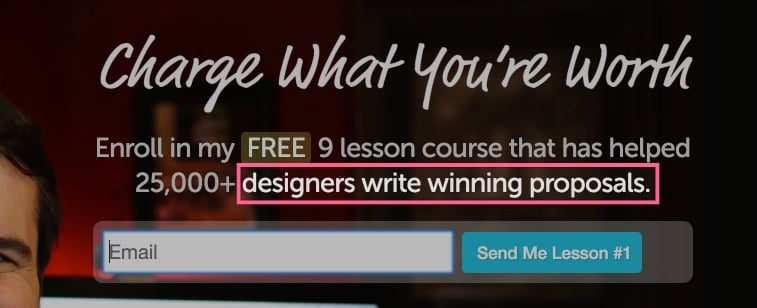
Compare the above homepage hero what someone who I know nothing about would get:
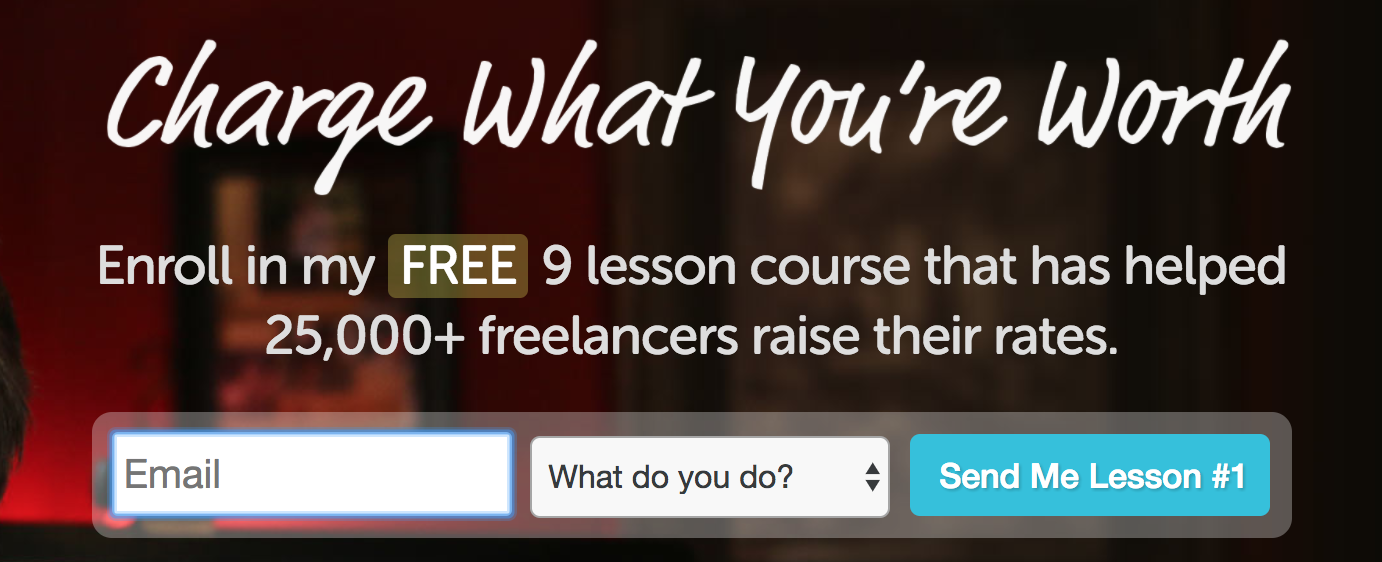
Opt-ins to this lead magnet **have increased 250%** – from 2% of unique visitors to 5% – since implementing this.
Action Step
What are the major landing pages or key pages that you could use to infer intent? Do you have industry-specific landing pages? Articles grouped into logical categories? Track the landing page someone arrived at, and use try to guess what you can about either who somebody is or what they want based on that. Write a cookie with the landing page and change parts of your website accordingly.
Strategy #3: One ad = one landing page
There are two components to any ad:
- The creative’s copy
- Who it’s targeted to
Platforms like Facebook or LinkedIn make it super easy to setup large numbers of ad variations that each target a specific type of person.
Really effective ad campaigns don’t drive all traffic to the same page, or at least they don’t drive traffic to a page that says the same thing to everyone. A rule of thumb is to make the headline on your landing page match the ad copy someone clicked on.
The big advertisers know this, but the implications are often overwhelming for everyone else. To do it right, you’re looking at building dozens (and sometimes, hundreds) of almost identical landing pages that have headline, supporting copy, social proof, and other variations.
Intercom hired full-time marketing engineers to do exactly this, and saw their AdWords conversions go from 4.33% to 13.03% – a 300% improvement!
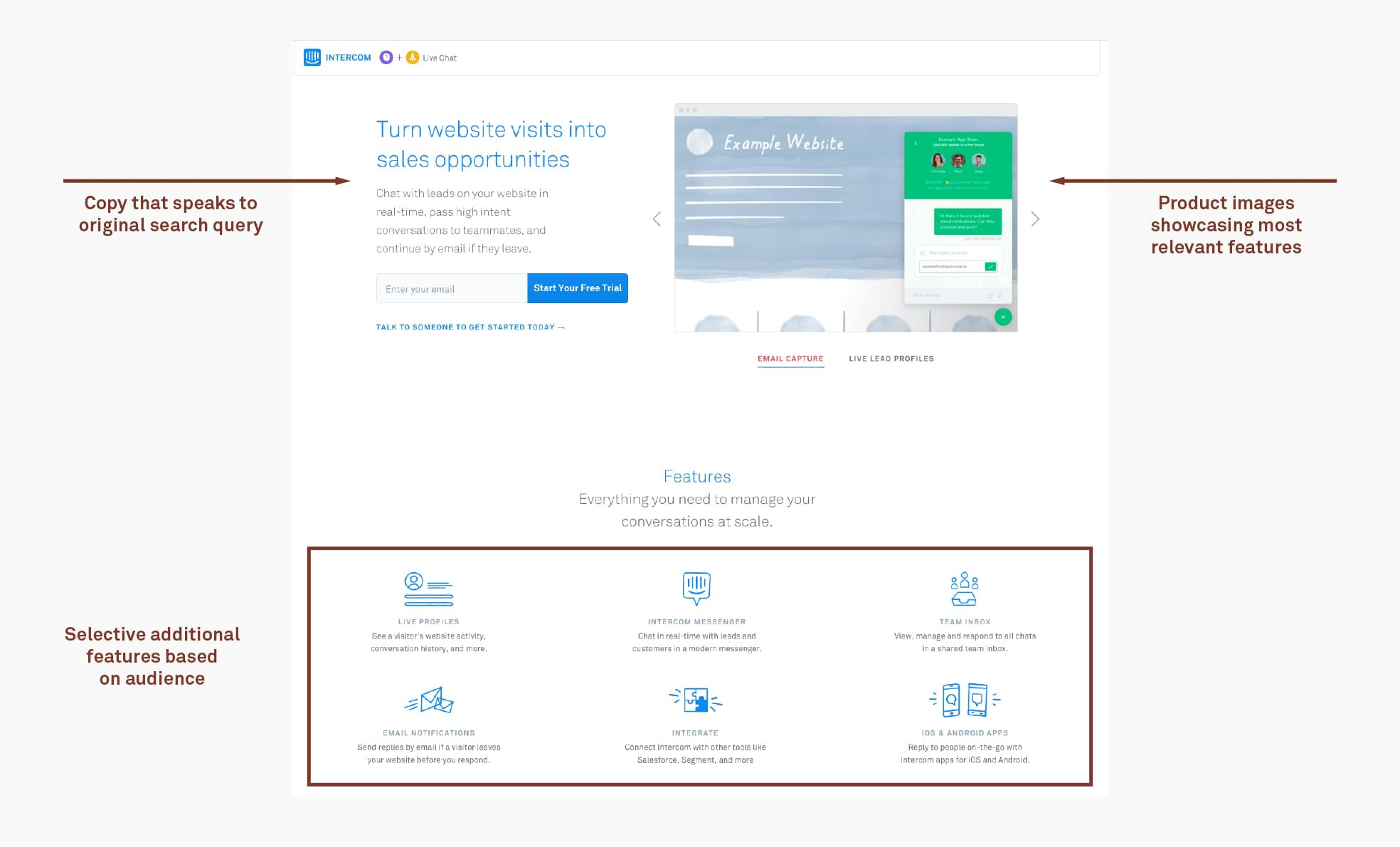
Their results aren’t unique.
One of our customers, who wishes to remain anonymous due to competition (we’ll call him R.), personalized the funnel that he was driving paid traffic into.
He took into account the ad copy and the niche audience the ad was targeting, and included that in the click-thru URL. Using that data, he was able to dynamically come up with on-the-fly variations.
This funnel had been consistently converting at around 22% for the last four years, and immediately after setting up his funnel personalizations, he was able increase conversions by 110% to 46% – effectively halving his cost-per-lead.
Action Step
Ensure that each of your ads has a unique URL (use UTM parameters to do this.) Then, on your landing page, change content and copy depending on the values of the passed in UTM parameters.
Strategy #4: Ask people what they want
Once somebody is on your list (or in some database of yours), the whole game changes.
You can use assessments, quizzes, data from Clearbit, trigger links, and more to enrich your leads, and then pass that data into your website.
One of my primary funnels for Double Your Freelancing is an email course that leads to a paid course. For RightMessage, it’s an on-demand workshop that ultimately brings somebody to our software.
Each of these funnels uses forms (as worksheets or assessments) and trigger links to write custom fields and tags to their subscriber record in Drip, the email marketing platform we use.
Then, when somebody who’s in our Drip database visits our website, we pull in that data and use that to determine what to change.
With the Double Your Freelancing funnel, the email course that people start with includes nine lessons. Each lesson ends with a question that’s answered by clicking on a trigger link:
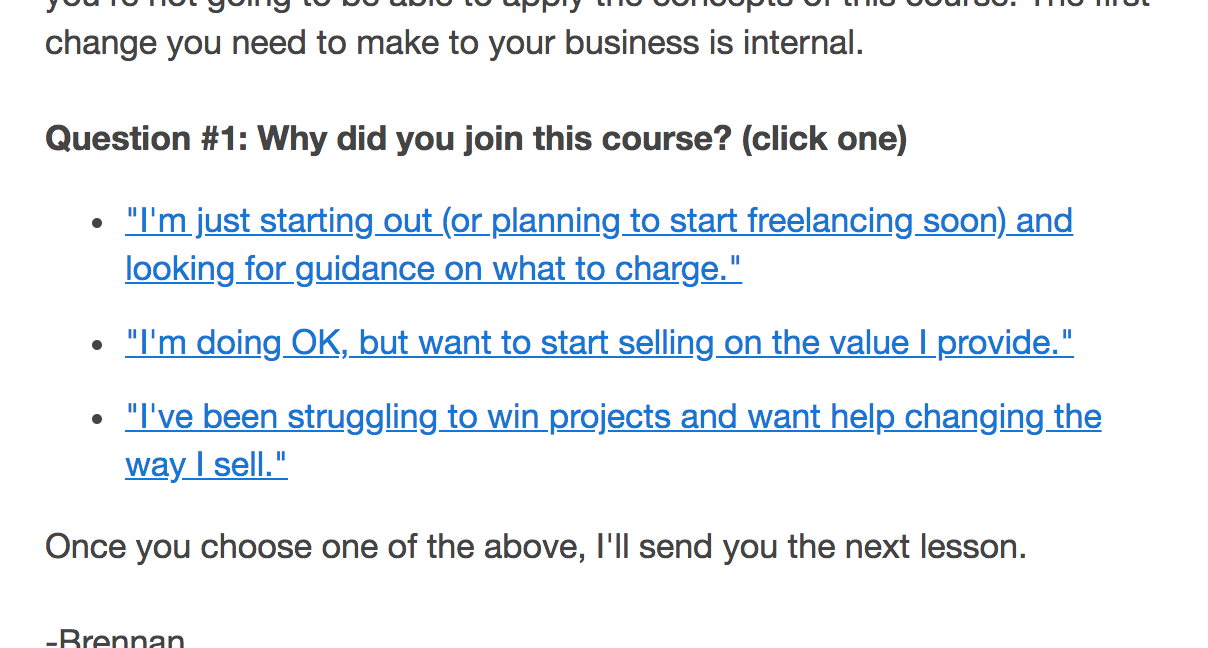
When clicked, I write a custom field to the subscriber. And by the end of the email course, I have at least six data points from 30% of the subscribers who go through the course.
When I later pitch the paid course, I take into account these data points and change the pitch emails and the sales page.
The sales page people arrive on have 84 total variations. This seems insane! However, overall sales are up by 70%.
And if you’re using personalization to render content dynamically, you really only have a single sales page with underlying code that, when fired, can result in a few dozen variations.
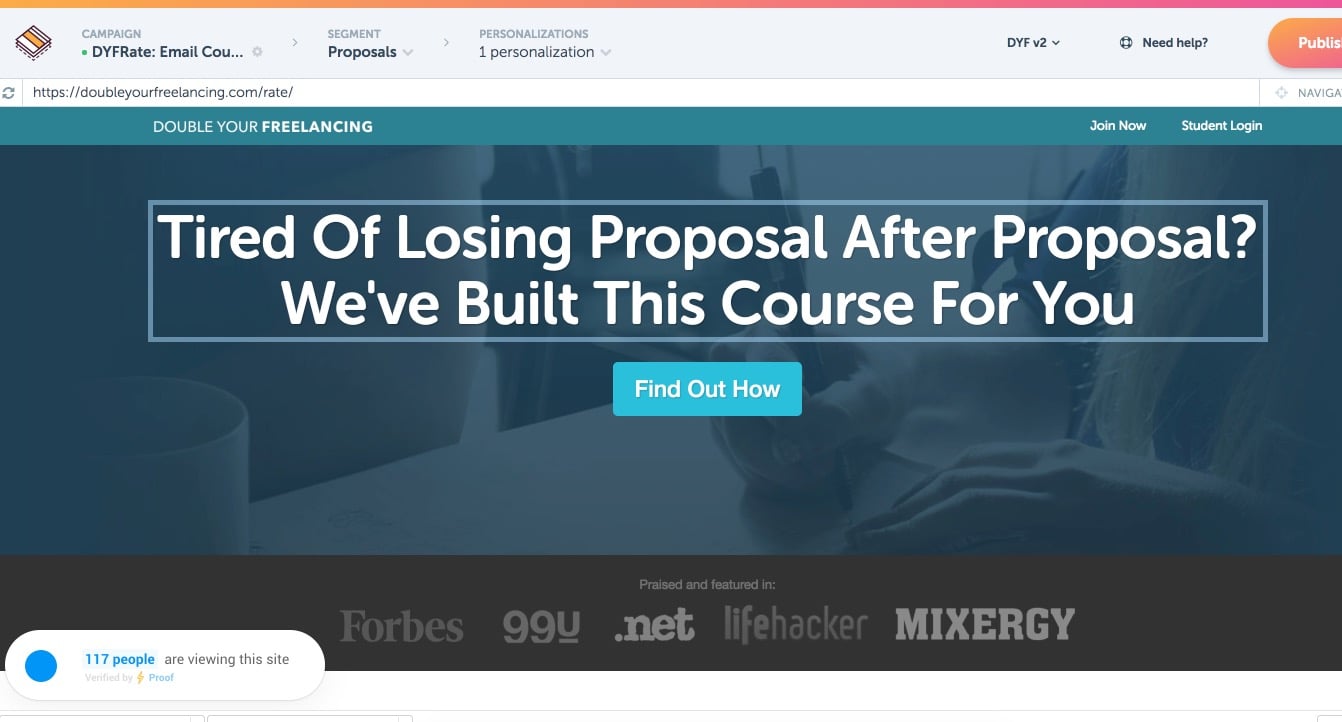
- Why they joined the email course (that is, the problem they have) is reinforced in the headline.
- Any instance of “freelancer” on the page is swapped out with “freelance designer” or “marketing agency” depending on what kind of business they run and the scale of it.
- Testimonials are shown from people who are like you. Designers see designers. Copywriters see copywriters. And so on.
- The offer – how I ask for the sale – changes based on the objections they told me they had when it came to implementing what I taught in the free course.
- …and more
I spent maybe one or two hours figuring out the copy changes I’d need to implement to run this campaign, but the results have been significant. There aren’t that many opportunities to get that kind of lift with so little effort.
Why does it work? Because people see a course that is positioned based on who they are, what they’ve told me they’re struggling with, and any concerns they have.
It’s exactly what I would do if I were trying to convince somebody over email or the phone to buy, but in a way that scales.
Action Steps
If you have data about your subscribers, pass that over to your website (just the fact of knowing whether someone IS or IS NOT a subscriber is something!) You’ll either want to pass all that info across with any link to your site (ugly) or, ideally, pass the contact ID of the subscriber, cookie it, and then hit your email marketing app’s API to pull that data.
Strategy #5: “Tell me what to do next”
A book that helped shape my early career as a web developer was Don’t Make Me Think.
The premise is simply: people, especially people on computers, are impatient and don’t want to figure out your site and its weird structure. Make it simple. My big takeaway was that people basically want to be told what to do. “Don’t make me think.” The problem is that many of us take a shotgun approach toward how we setup our call-to-actions.
Have you ever received an email from a company advertising their latest blog post, clicked on it, and been faced with a giant popup asking you for your email address?
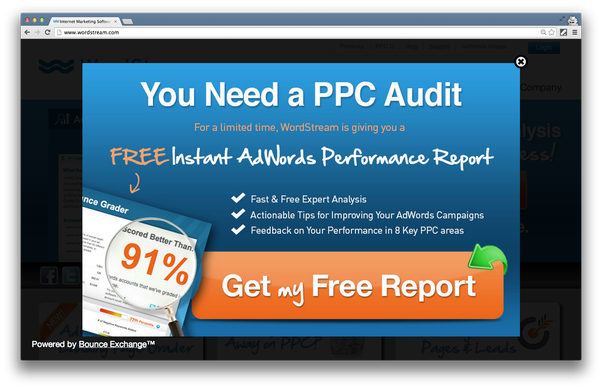
(Don’t do this to your subscribers, especially if they’ve already requested your PPC report!)
Silly.
Or have you ever been Googling around for answers, landed on an informational article, and was asked to… book a sales demo for some product you’ve never heard of? Or, worse, asked to buy something?
Another one of our customers, Christopher of Musical U, recently told us that they’ve seen a 62% increase in anonymous visitors who signed up.
What’d they do? They axed all the superfluous navigation elements and content for new visitors so that they could be funneled toward signing up. No distraction, just a single action they wanted new visitors to take.
And then those who were further down the funnel would be later promoted the product or offer that’s best for them.
Consider the typical SaaS company that creates content and sends it to their list (hey, Baremetrics!)
- Anonymous visitors (like someone who found the article on Twitter or Google) would be asked to join the list.
- Subscribers would be asked to book a demo or sign up for a trial.
- People going through a trial would be given a webinar or something that helps push them toward converting.
- And customers could be shown an annual upgrade offer.
The same article could be sent out to everyone, and the call-to-action could change depending on the relationship the reader has with Baremetrics.
Action Steps
At a minimum, cookie people who opt-in. If they have that cookie, don’t show an opt-in widget. Then get more sophisticated over time and take into account purchase history, etc.
Why do these strategies work?
Phone sales or live demos convert really well. Why? Because they’re highly personalized.
But meetings don’t scale very well.
Theoretically, your automated, low-touch communication with prospects, leads, and customers can scale infinitely.
Sending a more relevant, personalized email automation campaign to 50 people or 50,000 has nearly the same amount of time overhead. Ditto for your marketing site, blog, and other content you’re releasing online.
I see personalization as being the middle ground between low-touch, “say the same thing to everyone” and high-touch, highly-personalized sales.
So you’d expect the results to be somewhere in the middle, which, in most cases, means ridiculously high. And the customer examples I’ve shared – conversion increases of 84%, 110%, 32%, and so on – shows just what impact personalization can have.
I share these examples to help drive home the theory. Personalization works because relevancy is everything. Highly niched businesses are effective for those belonging to the niche they target, but they’re severely limiting.
People want to buy the product or service that was seemingly made just for them. And if you’re selling a product that has wide appeal, and your marketing and messaging attempts to cover all the bases, you’re losing people.
Plug the leaks in your software business’ sales funnel by implementing a few of the strategies I’ve covered above.
I promise it’ll be worth your while.
P.S. If the engineering takeaways I shared are overwhelming, our software makes it easy to implement these strategies and more in just minutes (without any coding), and we also seamlessly integrate with the major email marketing apps and CRMs. Sign up using this link and get a $99 credit.

